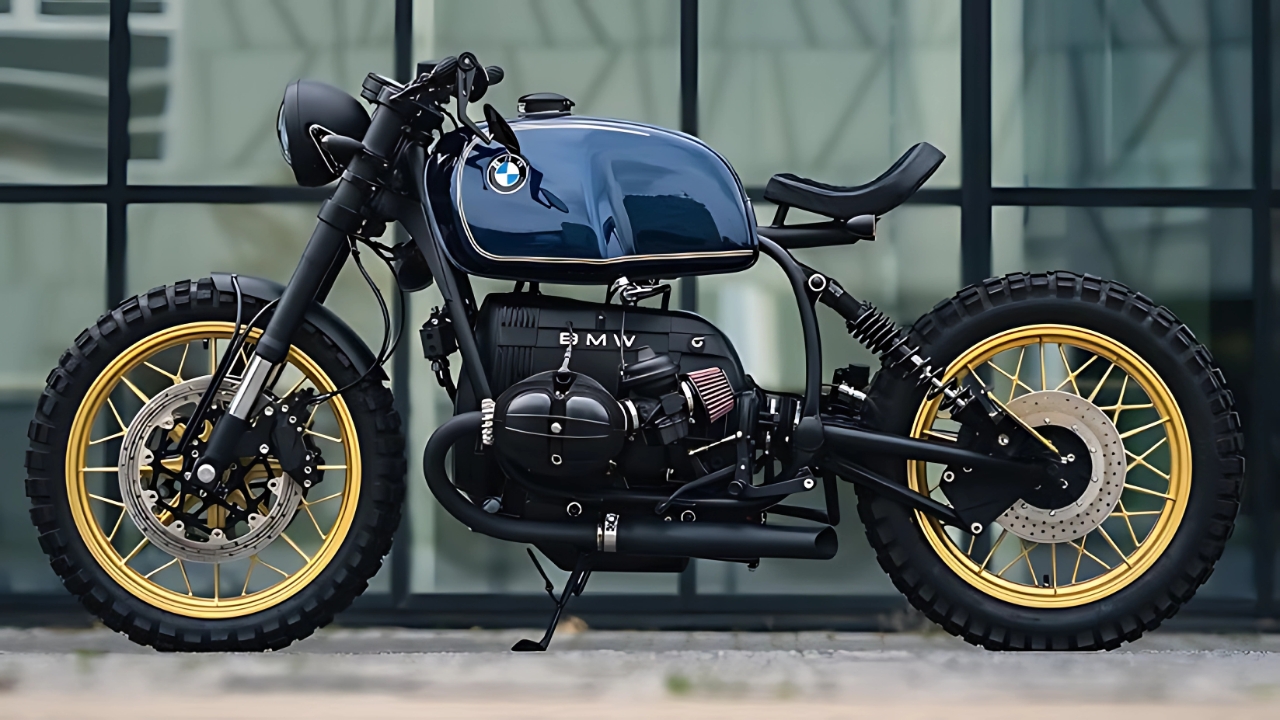It is a BMW R80 RT at its core, and it took the B Custom Cycle duo five long years to turn it into this mind-blowing cafe racer. When Marius and his teammate Lukas first acquired this donor motorcycle, they faced what many would consider an impossible challenge. The lack of time wasn’t the only problem, as the donor bike had certainly seen better days when it was purchased by Marius and his teammate. Many of its stock bits were corroded beyond repair, and even taking the old Beemer apart was a challenge due to all the rust.
Engineering Excellence: The Technical Transformation
The restoration process demanded meticulous attention to detail and innovative engineering solutions. They cleaned up the main frame following the initial teardown, while deleting the original subframe and installing a bespoke billet aluminum substitute in its stead. The custom aluminum subframe represents a perfect blend of strength and weight reduction, essential for achieving the cafe racer aesthetic.

According to NHTSA motorcycle safety standards, proper frame modifications must maintain structural integrity while meeting federal safety requirements for public road use.
Performance Specifications and Modifications
| Component | Original BMW R 80 RT | B Custom Cycle Build |
|---|---|---|
| Engine | 798cc Air-cooled Boxer Twin | Rebuilt 798cc with TRW Clutch |
| Power Output | 50 HP @ 6,500 RPM | Enhanced with Premium Filters |
| Exhaust System | Stock Dual Exhaust | Custom Titanium Headers + Ironhead Mufflers |
| Electronics | Original 12V System | Motogadget Controller + Li-Ion Battery |
| Rear Section | Factory Subframe | CNC-Machined Billet Aluminum |
Design Philosophy: Modern Innovation Meets Classic Aesthetics
Right behind it is one of the big highlights on this entire project – a 3D-printed tail section that really amps up the cafe racer flavor. The integration of modern manufacturing techniques like 3D printing showcases how contemporary technology can enhance vintage motorcycle builds without compromising authenticity.
The cockpit transformation includes clip-on handlebars, adjustable control levers, and a minimalist single aftermarket dial, creating an aggressive riding stance that defines the cafe racer experience. Billet foot pegs round out the ergonomics, complementing the clip-ons for an aggressive riding stance.

Electrical and Performance Upgrades
| System | Specification | Brand/Type |
|---|---|---|
| Battery | Lithium-Ion | Modern High-Performance |
| Regulator/Rectifier | Rick’s Motorsport | TRW Replacement |
| Wiring | Complete Rewire | Motogadget Controller |
| Lighting | LED Conversion | Custom Mounted |
The Heart of the Machine: Engine Resurrection
Perhaps the most challenging aspect of this five-year journey involved completely rebuilding the powerplant. The powerplant didn’t even run when the classic BMW got to the shop, so Lukas and Marius spent countless hours getting it back into working order. The comprehensive engine overhaul included gearbox and final drive restoration, ensuring reliability matches the stunning visual transformation.
The Federal Motor Vehicle Safety Standards for motorcycle modifications ensure that custom builds maintain safety compliance while allowing creative expression.
Visual Impact and Finishing Touches
Subdued grey pinstriping adorns the fuel tank, too, while items such as the frame and engine have been finished in black. Those red spark plug leads add a nice bit of contrast to the whole affair. The color scheme demonstrates how subtle design choices create maximum visual impact, transforming a corroded wreck into a showpiece.
Frequently Asked Questions
Q: How long did the BMW R 80 cafe racer build take?
A: The complete transformation took five years due to the extensive corrosion damage and custom fabrication requirements.
Q: What makes this build special compared to other cafe racers?
A: The combination of 3D-printed components, CNC-machined parts, and complete engine rebuilding sets this project apart from typical conversions.
Q: Can similar modifications be made to other BMW airhead models?
A: Yes, BMW R series motorcycles from the same era share similar architecture, making comparable modifications possible.
